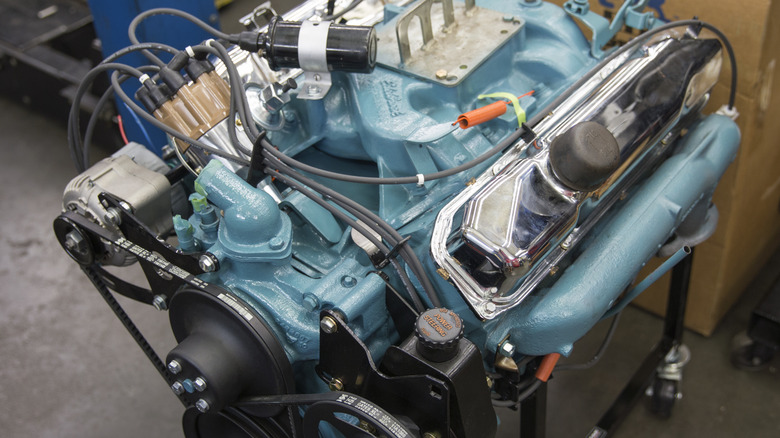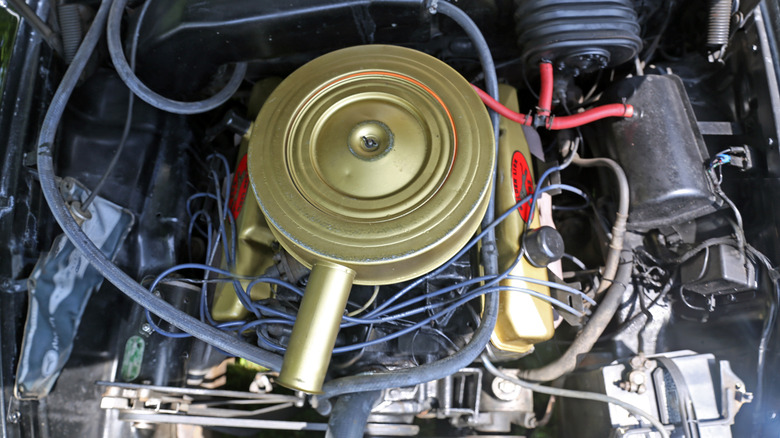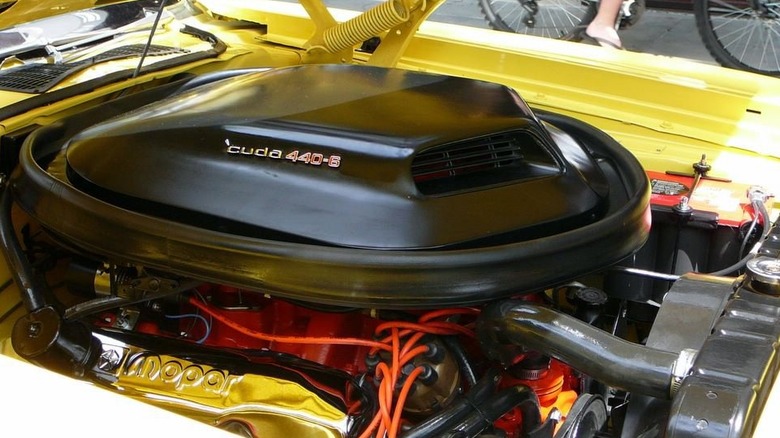Classic Mopar Power: What Made The 383 V8 Different From The 340 And 440 Engines?
In the late 1950s, Chrysler decided to cease production on its FirePower V8 engines. These were massive, hemispherical engines that would be revived in the mid-1960s and be rebranded to what we now commonly know to be the Hemi V8 engines. Back in the '50s, though, Chrysler was looking for a way to keep that big V8 power, but package it in an engine that was lighter. The company — alongside its engine manufacturer Mopar — had put into effect its small-block V8 A line of engines in 1956, but two years later, it introduced what would effectively replace the FirePowers: the large-block V8 B line. The A line would only last until 1961, where it was revamped three years later as the LA line.
Unlike the A line, the B line was actually made up of two different types of engines: B and RB. An RB engine had the same design principles as the Bs, with the wedge-shaped combustion chamber, but they were built to be taller in size. Each type had a variety of different engine displacements available, but those sizes were unique to the B or RB type. For example, a Mopar 440 engine was exclusively an RB engine. However, there was one that crossed over between the two, and that was the Mopar 383.
Though they had the same displacement, the two 383 V8s were distinctly different engines: Not just from themselves but from the likes of that Mopar 440, as well as the Mopar 340 LA engine that would come a few years later. Let's break down what made this engine stick out.
What separates the 383 B from the 383 RB?
The only one of the Mopar 383 V8 engines that made any kind of significant impact was the B version. Despite the fact that these two engines have the same engine displacement and are made by the same company, how they get to that displacement is different. The bore and stroke of the 383 B was 4.25 inches by 3.375 inches, which was the stroke length of all the B line engines. This first hit the market for the 1959 model year in vehicles like the Chrysler Town and Country, and it quickly became the go-to engine for many performance vehicles like the Dodge Charger, where it could reach an output up to 305 horsepower. It would hold this spot in the Chrysler line until 1971.
On the other hand, the Mopar 383 RB only had a lifespan of two years, and was introduced mostly as a stop-gap alternative. With its taller build, this engine had a bore and stroke of 4.031 inches by 3.75 inches. As to why Chrysler felt the need to make this engine, it's all about production efficiency. The 383 B engines were quite popular, but it could not easily convert a factory assembly line for building RB engines to B ones to satiate the need. Chrysler briefly made this 383 RB as a somewhat transitional engine before assembly line switching became easier. So, when people refer to a Mopar 383, they are most likely referencing the B engine.
More than just engine displacement
Comparing the Mopar 383 with the 340 and 440 seems a bit arbitrary: Yes, they are all made by the same company around the same time, and are V8 engines. Some vehicles were even equipped to handle multiple — if not all — of these engines under their hoods. However, there is no lineage to follow among these engines. It isn't as if the 383 is just the bigger next step after the 340. The 383 B was actually the first of them, followed by the 440 in '65 and the 340 in '68.
Also, none of these three engines came from the same family. The 383 and 440 big-blocks are somewhat related, as the 383 is a B engine while the 440 is an RB one. The 440 was the last of the RB line, boring out the 413 V8 for a larger displacement. Importantly, you could get the 440 in a high-output version called a Magnum, Super Commando, and Six-Pack, depending on the model and exactly how much output it could generate. That could max out at 390 horsepower with a Six-Pack model.
Meanwhile, the Mopar 340 was a small-block V8 from Chrysler's LA engine line. Made for lighter body vehicles, it could generate up to 275 horsepower, though in tests by MotorTrend found that to be underrated by about 45 horsepower. What does link these engines together is that all of them — as with most V8s — fell victim to the emissions standards changing in the 1970s, forcing all of them to fade away by the middle of the decade.


